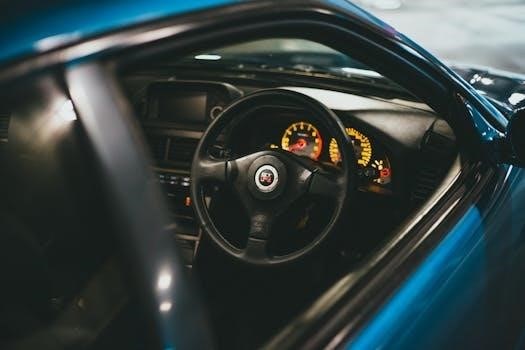The allure of a manual transmission in an E36 BMW is strong. Many enthusiasts opt for a manual swap to enhance driving feel and engagement. This process involves replacing the automatic components with a manual setup.
Why Consider a Manual Swap for Your E36?
Many BMW E36 owners contemplate a manual transmission swap to enhance the car’s driving experience. The manual provides a more direct connection to the road‚ offering greater driver control and engagement. Automatic transmissions‚ while convenient‚ often lack the responsiveness and sporty feel desired by enthusiasts. The swap can significantly improve the car’s performance‚ making it more enjoyable for spirited driving. Furthermore‚ a manual swap can increase the car’s value and appeal to those seeking a more traditional driving experience. The process‚ while involving‚ is often considered worthwhile for the enhanced driving pleasure it provides.

Required Parts for the Swap
A successful E36 manual swap necessitates specific parts like a manual transmission‚ driveshaft‚ pedal box‚ and the associated hydraulic components. These components are crucial for the conversion.
Manual Transmission and Driveshaft
The manual transmission‚ often the ZF 320Z found in E36 328i/M3 models‚ is the core of this swap‚ known for its strength. A driveshaft specific to manual transmission E36s is required‚ as the automatic version is a different length. The correct driveshaft ensures proper power transfer. This gearbox is capable of handling significant power‚ making it a popular choice for those wanting to enhance their vehicle’s performance. The 5th gear lean in this transmission is a known issue.
Pedal Box and Hydraulic Components
The pedal box from a manual E36 is essential‚ as it includes the clutch pedal mechanism. You’ll also require the master and slave cylinders for the hydraulic clutch system. These components work together to engage and disengage the clutch. The lines connecting the master and slave cylinders are crucial for proper fluid transfer. The hydraulic system is often a source of issues in SMG transmissions‚ so ensuring a proper setup here is paramount.
Transmission Crossmember
The transmission crossmember is a crucial mounting point and is different between automatic and manual models. The manual transmission crossmember is designed to properly support the manual gearbox. It is essential to replace the automatic crossmember with the correct manual one. This ensures the transmission sits correctly in the chassis. The crossmember is a structural component so you should make sure it is in perfect order. This is a bolt on swap‚ but the correct part is needed for this task.
Flywheel and Clutch Assembly
The flywheel and clutch assembly are unique to manual transmissions. The automatic setup is completely different and not compatible. You will need a manual specific flywheel‚ clutch disc‚ pressure plate and release bearing. These parts work together to allow gear changes. It is advisable to replace all these parts together to ensure smooth operation. When choosing‚ you can opt for upgraded‚ performance parts. The flywheel also provides the surface for the clutch to work. This is one of the most important pieces in the manual conversion.

ECU and Wiring Considerations
The ECU and wiring are crucial for a successful swap. The car needs to recognize the manual transmission. This might require reprogramming or even a replacement ECU.
ECU Reprogramming or Replacement
When undertaking an automatic to manual transmission swap in an E36‚ addressing the car’s Engine Control Unit (ECU) is paramount. The original ECU‚ programmed for an automatic‚ won’t work optimally with a manual. Therefore‚ you will need to either reprogram the existing ECU‚ if possible‚ or acquire a manual-specific ECU. Reprogramming may require specialized software‚ like DIS‚ and a good understanding of the ECU’s parameters. Alternatively‚ sourcing a manual ECU is a straightforward approach. Ensure the ECU you choose is compatible with your specific E36 model and engine. This step is crucial for proper engine performance and to avoid any potential issues after the swap;
Wiring Modifications for the Swap
The transition from an automatic to manual transmission in an E36 requires careful attention to the vehicle’s wiring harness. Automatic transmissions have different electrical needs compared to manual ones‚ necessitating modifications. This often involves bypassing or re-routing circuits related to the automatic transmission control unit. You might need to connect certain wires to simulate the presence of an automatic transmission‚ preventing fault codes and ensuring proper functionality of other systems. Some swaps might require adding wires for the reverse light switch on the manual transmission; Wiring diagrams specific to your E36 model are essential‚ and precision in splicing and connecting wires is crucial for success.
Differential and Gear Ratios
Manual E36s often have different differential gear ratios than automatics. The correct ratio is crucial for optimal performance after the swap. An M3 diff is often a desirable upgrade.
Differential Gearing Differences
Automatic and manual E36 models typically feature distinct differential gearing. Automatic transmissions often utilize higher (numerically lower) gear ratios‚ prioritizing fuel economy and relaxed cruising. Manual transmissions‚ conversely‚ tend to have lower (numerically higher) gear ratios‚ which enhance acceleration and responsiveness. The differential gearing must be considered when swapping to a manual transmission to ensure that the final drive ratio matches the needs of the manual transmission and the desired driving characteristics. An incorrect ratio can result in a significant decrease in performance and incorrect speedometer readings.

Step-by-Step Swap Guide (General Overview)
The swap begins with careful disassembly‚ followed by installation of manual components. This includes the pedal box‚ transmission‚ and associated parts. Proper wiring and ECU adjustments are crucial for a successful conversion.
Preparation and Disassembly
Before commencing the manual swap‚ ensure the vehicle is safely supported. Disconnect the battery to prevent electrical issues. Begin by removing the automatic transmission‚ driveshaft‚ and associated components. Carefully detach the automatic shifter assembly and any wiring related to the automatic transmission control. It’s essential to label all disconnected wires and parts for easy reassembly or reference later. Thoroughly clean the engine bay and transmission tunnel to ensure a smooth installation of the new components. This step is crucial for a successful swap and to avoid any unnecessary hurdles. Proper preparation is key to an efficient and trouble-free process.
Installation of Manual Components
With the automatic components removed‚ begin installing the manual transmission and driveshaft. Secure the transmission crossmember designed for manual configurations. Mount the manual pedal box‚ ensuring proper alignment and functionality. Install the flywheel and clutch assembly‚ adhering to torque specifications. Connect the hydraulic lines for the clutch master and slave cylinders. Carefully route any necessary wiring for the manual setup. Double-check all connections and mountings for security and proper fit. Test the clutch pedal for smooth operation and proper engagement. This step requires precision and attention to detail for a successful transition to the manual system.
Cost and Budgeting
Budgeting for a manual swap is crucial. Parts costs vary‚ so research is key. Consider both parts and potential labor costs‚ as they significantly affect the total expense.
Parts Costs and Sourcing
The cost of parts for an E36 manual swap can vary widely. Sourcing used components from a donor car can be a cost-effective approach‚ but be sure to inspect all items carefully. New parts‚ although more expensive‚ offer reliability and peace of mind. Consider exploring online marketplaces and specialist BMW parts suppliers to get the best deals. Don’t be afraid to haggle‚ as there are more parts available than you might initially think. Also‚ look out for complete swap kits. These kits can simplify the process by bundling everything you need into one purchase‚ so ensure you compare prices before deciding.
Potential Labor Costs
Labor costs for an E36 manual swap can significantly impact the overall budget. If you’re not comfortable with the work‚ hiring a mechanic is necessary. The complexity of the swap means labor charges can vary widely depending on the mechanic’s hourly rate and the estimated time to complete the job. Some shops may offer a flat rate for the whole swap‚ which can help you budget. It is crucial to get quotes from several shops to compare prices. Factors that affect the cost include the shop’s experience with BMWs‚ and the condition of your car.

Common Issues and Troubleshooting
Manual swaps can introduce new problems. Hydraulic systems and gearbox issues are common. Proper diagnosis and careful installation are crucial for a successful conversion.
Problems with Hydraulic System
The hydraulic system‚ crucial for clutch operation‚ often presents challenges during an E36 manual swap. Issues like a failing master or slave cylinder can lead to clutch engagement problems and a soft pedal feel. Air in the system is another common culprit‚ requiring careful bleeding to restore proper function. Leaks within the hydraulic lines or connections can also cause a loss of pressure and a non-functioning clutch. Thorough inspection of all components‚ including the lines‚ master cylinder‚ and slave cylinder‚ is essential. The SMG transmissions used by BMW in their M cars often struggle with the clutch hydraulic end. Proper diagnosis and repairs can be difficult‚ but are essential to ensure a functional manual transmission.
Gearbox Issues
Gearbox issues can arise during an E36 manual swap‚ often stemming from a used unit. Common problems include difficulty shifting into certain gears‚ grinding noises‚ or a general feeling of sloppiness. The ZF 320Z 5-speed gearbox is popular for its strength; however‚ a common issue with this model is a 5th gear lean where the shifter has no resistance when leaning right from its neutral position. It is important to inspect the transmission thoroughly before installation‚ checking for any signs of damage‚ wear‚ or leaks. Proper fluid levels and the correct type are also crucial. Addressing these issues early will help ensure a smooth and reliable manual driving experience in your E36.
